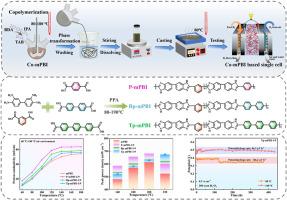Rigid hydrophobic group-modified polybenzimidazole as proton exchange membranes for high-temperature fuel cells
IF 9
1区 工程技术
Q1 ENGINEERING, CHEMICAL
引用次数: 0
Abstract
Superior overall performance is crucial for advancing high-temperature proton exchange membrane fuel cells (HT-PEMFC). In this study, we report a series of polybenzimidazole copolymer membranes by incorporating various aromatic rigid hydrophobic units (phenylene, biphenyl, and terphenyl) into poly(2,2′-m-(phenylene)-5,5′-bibenzimidazole) (mPBI) main chains. These membranes show increased free volume and hydrophobic properties. As a result, after doping with phosphoric acid, the HT-PEMs demonstrate enhanced oxidative stability and good PA retention across different relative humidity and temperatures. The fuel cell based on PA-doped Tp-mPBI-1/9 with terphenyl exhibits the highest peak power density retention after cycling from 1 V to 0.1 V at different low temperatures (80 °C/40 °C). Furthermore, Tp-mPBI-1/9 delivers steadily increasing single-cell performance (675 mW cm−2) at 220 °C and effectively broadens the operating window. Stability testing of Tp-mPBI-1/9-based single cells at 0.3 A cm−2/160 °C resulted in a voltage decay rate of 73.2 μV h−1. Based on their excellent comprehensive performance, fine-tuning of the PBI backbone structure optimized the PBI membranes for HT-PEM applications.

高温燃料电池用刚性疏水性基团修饰的聚苯并咪唑质子交换膜
优异的综合性能是推进高温质子交换膜燃料电池(HT-PEMFC)发展的关键。在这项研究中,我们报道了一系列通过在聚(2,2 ' -m-(苯基)-5,5 ' -双苯并咪唑)(mPBI)主链中加入各种芳族刚性疏水单元(苯基、联苯和terphenyl)的聚苯并咪唑共聚物膜。这些膜显示出增加的自由体积和疏水性。结果表明,在磷酸掺杂后,HT-PEMs在不同的相对湿度和温度下都表现出更强的氧化稳定性和良好的PA保留率。在不同低温(80°C/40°C)下,从1 V循环到0.1 V时,基于pa掺杂Tp-mPBI-1/9的燃料电池的峰值功率密度保留率最高。此外,Tp-mPBI-1/9在220°C下提供稳定增加的单电池性能(675 mW cm - 2),并有效地拓宽了操作窗口。基于tp - mpbi -1/9的单细胞在0.3 A cm−2/160°C下的稳定性测试结果显示,电压衰减率为73.2 μV h−1。基于PBI膜优异的综合性能,对PBI膜的骨架结构进行了微调,优化了用于HT-PEM应用的PBI膜。
本文章由计算机程序翻译,如有差异,请以英文原文为准。
求助全文
约1分钟内获得全文
求助全文
来源期刊

Journal of Membrane Science
工程技术-高分子科学
CiteScore
17.10
自引率
17.90%
发文量
1031
审稿时长
2.5 months
期刊介绍:
The Journal of Membrane Science is a publication that focuses on membrane systems and is aimed at academic and industrial chemists, chemical engineers, materials scientists, and membranologists. It publishes original research and reviews on various aspects of membrane transport, membrane formation/structure, fouling, module/process design, and processes/applications. The journal primarily focuses on the structure, function, and performance of non-biological membranes but also includes papers that relate to biological membranes. The Journal of Membrane Science publishes Full Text Papers, State-of-the-Art Reviews, Letters to the Editor, and Perspectives.
 求助内容:
求助内容: 应助结果提醒方式:
应助结果提醒方式:


